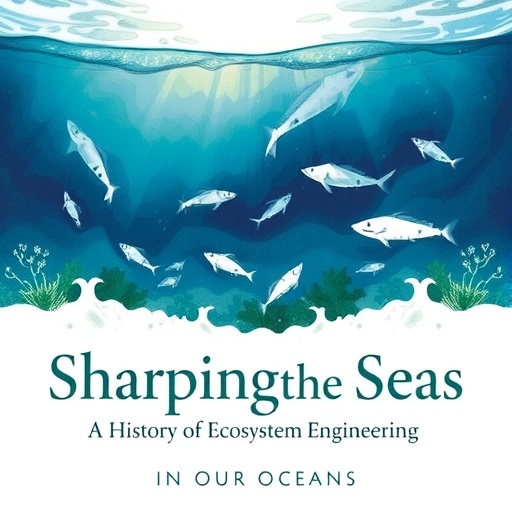New Haven, Conn. — The hidden processes taking place deep beneath the ocean floor are gradually being unveiled through groundbreaking research that charts the evolution of marine sediment layers over a staggering 540 million years of Earth’s history. This comprehensive study sheds new light on the biological activity that reshaped the seafloor, emphasizing the crucial role of ancient and modern burrowing animals in manipulating sediment structures—a process known as bioturbation.
Bioturbation refers to the intricate excavation and mixing of sediments and soils by burrowing organisms, primarily in search of shelter or food. This phenomenon, though often overlooked, fundamentally transforms marine sedimentary environments. It impacts nutrient cycling, sediment oxygenation, and overall ecological dynamics in the oceanic benthic realm. The research, led by Lidya Tarhan, an assistant professor of Earth and planetary sciences at Yale University, dives deep into understanding how bioturbation has evolved alongside animal life and environmental changes over hundreds of millions of years.
Unlike prior studies limited to contemporary data, Tarhan and her colleagues embarked on an extensive journey through geological epochs, employing a multifaceted approach. Their research combined fresh observations from geologic fieldwork conducted across several continents including North America, Europe, and Australia, with analysis of sediment cores retrieved from modern marine settings. Importantly, they integrated findings from more than one thousand previously published scientific works to assemble the most comprehensive database on bioturbation activity ever compiled. This monumental synthesis allows the reconstruction of bioturbation intensity and patterns across an evolutionary timescale nearing the origin of animal life.
Significantly, the study reveals that the primary modes of bioturbation—namely sediment mixing and deep burrowing—did not co-evolve simultaneously but rather followed distinct temporal trajectories. Early in animal evolution, deep burrowing activities were already prevalent, as worms and other primitive organisms dug into sediment layers to create tunnels. However, the dynamic mixing of sediments, which requires higher energy expenditure, emerged far more gradually. This differentiation elucidates how changing oceanic conditions and animal physiology might have shaped the pace and nature of sediment disturbance through deep time.
Oceanic oxygen availability emerges as a pivotal factor in governing the evolution of bioturbation. During epochs marked by warm, ‘greenhouse’ climates, oxygen levels in seafloor waters were notably lower. Higher temperatures increase metabolic rates and oxygen demands of benthic animals, suggesting that energetically costly sediment mixing would be less favored under these conditions. As such, the persistence of low oxygen likely constrained the development of more active and disruptive sediment mixing behaviors compared to simpler, less demanding burrowing activities.
Notably, the research chronicles how bioturbation dynamics responded to several of Earth’s major environmental upheavals, including mass extinction events. The End-Permian extinction, approximately 252 million years ago, represents a stark example. This event led to the near-complete cessation of bioturbation, as widespread species die-offs decimated benthic communities. Only after a prolonged recovery interval did small horizontal burrows start to reappear, hinting at the gradual restoration of animal activity and sediment disturbance after such catastrophic ecological collapse.
Understanding these bioturbation histories is more than an academic pursuit; it holds profound implications for deciphering the mechanisms behind the extinction and recovery of ecosystems. The temporally resolved patterns of how seafloor engineers rebounded from mass extinctions provide vital clues about the resilience of marine systems and their ability to restore nutrient cycling functions critical to ocean health. The attenuation and resurgence of bioturbation serve as proxies for broader ecological stability and functional rebuilding.
Furthermore, this research raises pressing questions about the current biodiversity crisis unfolding in marine environments worldwide. Given that bioturbators are essential in maintaining sediment health and oceanic nutrient dynamics, their responses to anthropogenic stressors and extinction pressures are crucial to anticipate. The murky evolutionary narrative of bioturbation’s past, marked by delayed recoveries and sensitivity to oxygen fluctuations, hints at the complexity and unpredictability of how present-day marine ecosystems might respond to rapid environmental changes.
The collaboration that produced this study includes expertise across multiple disciplines and institutions—from Yale’s earth science laboratories to marine geology groups at the University of Southampton and the University of California campuses. Their interdisciplinary approach underscores the necessity of integrating paleontological, geological, and ecological perspectives to truly grasp the multifaceted nature of sediment bioturbation.
This research was made possible by generous funding from Yale University and the support of a National Science Foundation graduate research fellowship. It not only highlights a vital yet underappreciated ecosystem engineering process but redefines our understanding of how life shapes the planet’s surface over geological timescales. By tracing the incremental evolution of marine sediment mixing and burrowing through hundreds of millions of years, the study opens new windows into Earth’s deep past and offers insights that resonate with pressing environmental challenges in the present.
Through meticulous analysis of fossil burrows and sediment disturbance intensities, the study provides a refined timeline on when marine animals transitioned from simple burrowers confined mostly to shallow environments, to active sediment mixers that profoundly impact the seafloor habitat even in deeper ocean settings. This transition has crucial consequences for the cycling of nutrients and organic matter, thus sustaining complex marine ecosystems.
Ultimately, this work elevates bioturbation as a fundamental Earth system process, a form of ecological engineering comparable in importance to biogeochemical cycling and climate regulation. As the oceans continue to face unprecedented pressures from climate change, pollution, and habitat loss, understanding the evolutionary legacy and functional capacities of bioturbators will be pivotal to predicting and managing the health of marine environments globally.
Subject of Research:
Article Title: Tracking bioturbation through time: The evolution of the marine sedimentary mixed and transition layers
News Publication Date: 30-Jul-2025
Web References: http://dx.doi.org/10.1126/sciadv.adu7719
References: Science Advances, DOI 10.1126/sciadv.adu7719
Keywords: Sea floor, Sedimentology, Paleontology, Paleobiology




